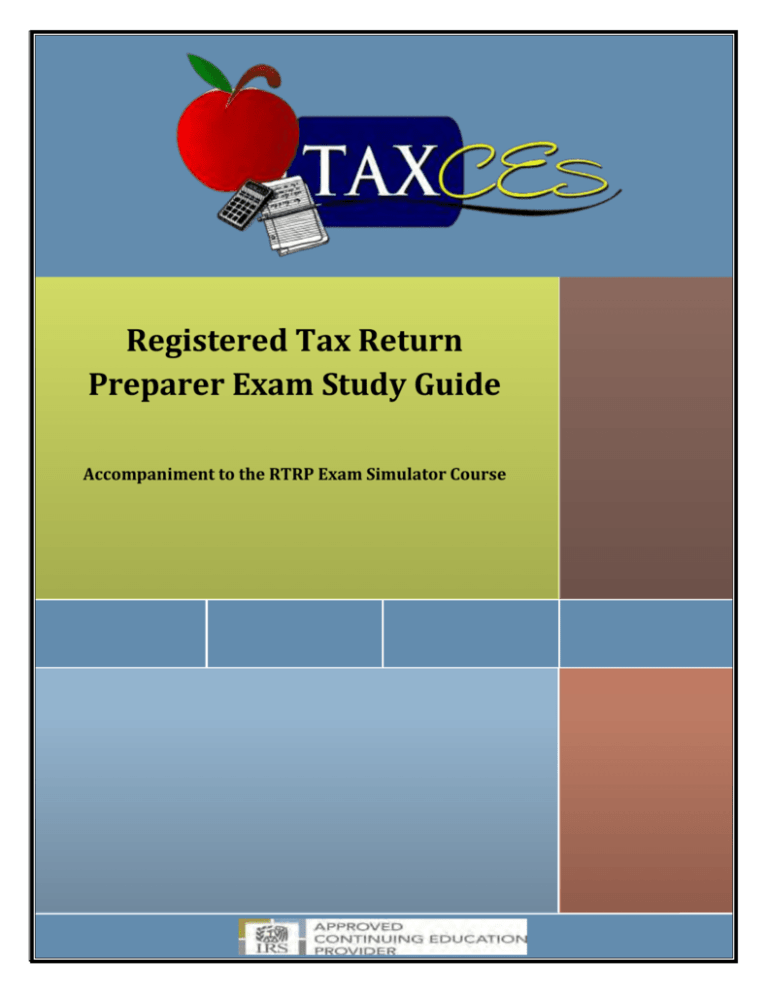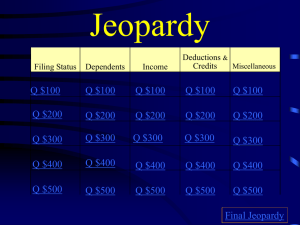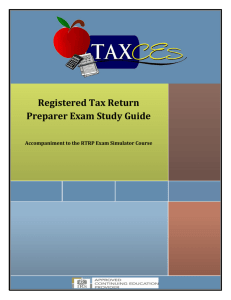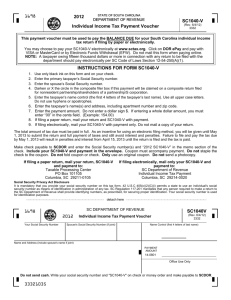
Registered Tax Return
Preparer Exam Study Guide
Accompaniment to the RTRP Exam Simulator Course
0|Page
TaxCES.com
A Service of 1040 Education, LLC
Registered Tax Return Preparer Exam Study Guide
RTRP Simulator Course Accompaniment
Table of Contents
Exam Overview ............................................................................................................................................. 2
Actual Exam Day ........................................................................................................................................... 3
Test Tips and Strategies ................................................................................................................................ 3
Exam Details .................................................................................................................................................. 4
Domain 1 ....................................................................................................................................................... 7
Domain 2 ..................................................................................................................................................... 32
Domain 3 ..................................................................................................................................................... 51
Domain 4 ..................................................................................................................................................... 79
Domain 5 ..................................................................................................................................................... 89
Domain 6 ................................................................................................................................................... 105
Domain 7 ................................................................................................................................................... 115
1|Page
Exam Overview
The Registered Tax Return Preparer (RTRP) Exam is designed to identify individuals
who meet minimum competency to preparer 1040-series tax returns. The IRS has
undergone significant efforts to develop questions based on general tax rules covered in
the IRS publications.
Paid tax preparers who are not attorneys, certified public accountants, or enrolled
agents must pass the RTRP exam by December 31, 2013 in order to become
Registered Tax Return Preparers.
This study guide, along with the exam simulator course, will help you become proficient
in passing the test.
To assist in test preparation, the following is a list of recommended by the IRS as study
materials. This list is not all-encompassing, but a highlight of what the test candidates
will need to know.
Form 1040
Form 1040 Instructions
Publication 17: Your Federal Income Tax
Circular 230 (Rev. 8-2011): Regulations Governing Practice Before the Internal
Revenue Service
Publication 334: Tax Guide for Small Business
Publication 970: Tax Benefits for Education
Form 6251: Alternative Minimum Tax – Individuals
Form 6251 Instructions
Form 8879: IRS e-File Signature Authorization
Publication 596: Earned Income Credit
Form 8867: Paid Preparers Earned Income Credit Checklist
Form 2848 (Rev. October 2011): Power of Attorney and Declaration of
Representative
Form 2848 Instructions (Rev. October 2011)
Form 8821 (Rev. October 2011): Tax Information Authorization
Publication 1345 (Rev. 3-2009): Handbook for Authorized IRS e-file Providers
Publication 4600 (Rev. October 2008): Safeguarding Taxpayer Information Quick
Reference
2|Page
Actual Exam Day
On the exam day, you should arrive at least 30 minutes before your scheduled time.
Bring an official government-issued photo ID containing your signature. Personal items
are NOT allowed in the exam area and must be stored in a locker. You may want to
bring a light jacket or sweater with you.
The following three reference materials will be the only items accessible electronically
during the exam:
Publication 17
Form 1040
Form 1040 instructions
Test Tips and Strategies
You will be successful in passing the exam if you adequately prepare and effectively
execute your knowledge during the exam.
The exam covers seven major areas, which are also known as IRS domains. The exam
coverage will be broken down as follows:
Domain 1: Preliminary Work and Collection of Taxpayer Data-15%
Domain 2: Treatment of Income and Assets-22%
Domain 3: Deductions and Credits-22%
Domain 4: Other Taxes-11%
Domain 5: Completion of the Filing Process-10%
Domain 6: Practices and Procedures-5%
Domain 7: Ethics-15%
Follow these tips:
1) Become very familiar with Publication 17. The exam DOES expect for you to
know form numbers and threshold or qualifying amounts for certain deductions
and credits. Use the Publication 17 index hyperlinks wisely. The test simulator
you purchased is designed to help you become acclimated with looking up
3|Page
2)
3)
4)
5)
pertinent data on Publication 17. We highly suggest you utilize the test
simulator‘s hints to look up answers. Doing so will train you in become adept in
navigating Publication 17 quickly.
Try to determine the correct answer and eliminate incorrect answers that are
obviously wrong.
Manage the clock. Do not become ‗stuck‘ on a question.
Guess if necessary. Do not leave any blank answers. Blank answers will be
counted as wrong.
Practice exam questions. The best way to prepare for the actual test is to take
practice tests that mimic exam conditions.
Exam Details
Number of RTRP Test questions
The Registered Tax Return Preparer competency test contains 120 questions, 100
scored questions, and 20 experimental questions in multiple-choice and true or false
format. You will have 2.5 hours to complete the test.
Exam Time Limit
The actual test will be limited to 2 ½ hours. You may take an optional pre-test computer
system tutorial.
Experimental Questions
The RTRP test will include 20 experimental questions. These questions are the source
for future test questions. These questions do not count as part of your score, but you
will not be told which questions they are. Since you will not know which questions are
experimental, try your best on every question.
RTRP Test scores
You will receive a notice at the end of your test indicating that you have completed the
test. Printed test results will be provided immediately following the test.
Scaled scores are determined by calculating the number of questions answered
correctly from the total number of questions in the test and converting to a scale that
ranges from 50 to 500. Some test questions may be weighted. The IRS has set the
scaled passing score at 350, which corresponds to a minimum level of knowledge
deemed acceptable for the tasks performed by a minimally competent Registered Tax
Return Preparer.
4|Page
Privacy of Test Scores
Individual test results are confidential and the IRS will not reveal your results to anyone
but you. NO ONE knows your score except the IRS and the candidate.
5|Page
Disclaimer
This publication is intended for educational purposes and to provide accurate and
authoritative information in regard to the subject matter covered. This publication is not
intended to render any legal, accounting, or professional advice. If legal advice or other
expert advice or service is required, a competent professional should be sought.
The author and affiliated parties are not legally bound by this text, any accompanying
electronic media, or lecture in the rendering of legal, tax, accounting, or similar
professional services. While the legal, tax, and accounting issues discussed in this
material have been reviewed with sources believed to be reliable, concepts discussed
can be affected by changes in the law or in the interpretation of such laws since this text
was printed. For that reason the accuracy and completeness of this information and the
author's opinions based thereon cannot be guaranteed. In addition, state or local tax
laws and procedural rules may have a material impact on the general discussion. As a
result, the strategies suggested may not be suitable for every individual. Before taking
any action, all references and citations should be checked and updated accordingly.
Copyright © 2012
by 1040 Education. LLC
All rights reserved.
Course materials may not be reproduced or stored in a retrieval system without prior
written permission of the publisher and in no case for profit.
6|Page
Domain
7|Page
1. Review prior year’s return for accuracy, comparison, and carryovers for
current year return.
Preparers should exercise care and review the client‘s prior-year tax return for
carryovers (i.e. depreciation, NOL, and capital loss carryforwards).
If the client is new, the preparer should request at least one prior year tax return.
Carryforwards, such as prior depreciation, capital loss, and NOLs need to be
accurately accounted for on the current return.
Every return must be complete and accurate. Check the prior return to ensure the
following:
7|Page
Use of correct forms. There are many forms that may be used. Be sure
that each entry has the associated corresponding schedule (when
applicable). If carryforwards are present, they should be presented on the
current return.
Each entry contains accurate and correct information.
Each form used must be complete. Data contained on each form should
be consistent across all forms.
2.
Collect taxpayer’s biographical information (e.g., date of birth, age, marital
status, citizenship, dependents)
The taxpayer‘s personal biographic information must be accurate and complete.
Name
If the taxpayer‘s name has legally changed, the name change should be reported
to the Social Security Administration before the tax return is filed. The name
reported to the IRS should match the Social Security Administration‘s
information.
Date of Birth
Although the taxpayer‘s date of birth is not directly input on the return, it is
needed to determine certain calculations such as the additional standard
deduction for those who are 65 and over. For tax purposes, the taxpayer‘s age is
calculated using the day before his birthday.
Example: Sonny was born on January 1, 1947. He is considered to be age 65
on December 31, 2011.
Marital Status
The taxpayer‘s marital status is determined based on the last day of the year
(e.g. if a client is becomes legally married on December 31, 2012, he is
considered married for tax year 2012).
Citizenship
In most cases, U.S. citizens or resident aliens living abroad must file a tax return.
The type of tax return to file is dependent upon whether the alien taxpayer is
considered to be a resident alien, nonresident alien, or dual-status taxpayer. IRS
8|Page
Publication 519, U.S. Tax Guide for Aliens provides a comprehensive overview
on determining status.
3.
Determine filing status
Filing status is based on marital status and family situation. If a person qualifies for
more than one filing status, he should generally choose the most advantageous tax
status.
The five filing statuses are single, head of household, qualifying widow(er) with
dependent child, married filing jointly, and married filing separately.
a. Single persons are those who are unmarried, legally separated, divorced,
or who do not qualify for another filing status.
The unmarried status refers to any individual who is not legally married
as of the last day of the tax year.
Annulled marriages that are court decreed will result in a status of
unmarried. If joint returns were filed for previous years, amended returns
must be filed for the tax years affecting the annulment unless they are
closed by the statute of limitations, which usually is 3 years after the tax
year closes.
9|Page
Divorced persons are those who were divorced as of the last day of the
tax year and are, therefore, considered unmarried (divorced) for the whole
year.
Individuals who divorce and then remarry for the purpose of gaining
a better tax rate must file as married individuals.
b. Head of Household
The taxpayer must be unmarried and pay more than half the cost of
maintaining a home for himself and another person who lives with the
taxpayer for over half the year (unless the qualifying person is a parent
who does not have to live with the taxpayer). The qualifying person for
whom the taxpayer maintains a home must be qualified to be claimed as
a dependent. A qualifying relative may be the taxpayer‘s son, daughter,
grandchild, or sibling who lived with the taxpayer for more than half the
year.
Note: If the taxpayer‘s son or daughter is married and the taxpayer cannot claim an
exemption for the child, the daughter/ son is not a qualifying person.
Note: If the taxpayer cannot claim an exemption for the taxpayer‘s parent, the parent is
not a qualifying person.
c Qualifying Widow(er) with Dependent Child The taxpayer may be
eligible to use qualifying widow(er) with dependent child as his filing
status for two years following the year his spouse died. For example, if
the spouse died in 2011 and the taxpayer has not remarried, he may be
able to use the qualifying widow(er) filing status for 2012 and 2013. Note
that in the year of the spouse‘s death, if the taxpayer qualifies, he may file
using the married filing jointly status.
The married filing jointly status entitles the taxpayer to use joint-return tax rates and the
highest standard deduction amount (if he does not itemize deductions).
d. Married Filing Jointly (MFJ) Taxpayers can choose married filing jointly
as their filing status if they are married and both spouses agree to file a
joint return. They should report their combined income on the tax return
and deduct their combined allowable expenses. They can file a joint
return even if one of the spouses has no income or deductions.
10 | P a g e
If the taxpayers decide to file a joint return, their tax may be lower than their combined
tax for the other filing statuses. Also, the standard deduction (if they do not itemize
deductions) may be higher, and they may qualify for tax benefits that do not apply to
other filing statuses.
e. Married Filing Separately (MFS) Taxpayers can choose the married
filing separately even if they are married. The MFS filing status generally
provides fewer tax benefits than filing joint returns because MFS
taxpayers are ineligible to claim the following tax benefits:
Tuition and fees deduction
Hope, Lifetime Learning Credit, or American Opportunity Credit
Student loan interest deduction
Tax-free exclusion of US bond interest
Tax-free exclusion of Social Security Benefits
Credit for the Elderly and Disabled
Child and Dependent Care Credit
●
Earned Income Credit
If one MFS taxpayer claims the standard deduction, the other spouse may not itemize.
Both must either claim the standard deduction or both must itemize their deductions.
The MFS status tax rate will generally be higher joint tax return rate. The exemption
amount for figuring the AMT will be half the amount that is allowed for a joint tax return.
The following child tax credit and retirement savings contribution credits are reduced at
income levels that are half of those for a joint return. In addition, the capital loss
deduction limit is $1,500 (instead of $3,000 if you filed a joint return).
MFS taxpayers often choose this status to separate tax liabilities. By filing a separate
tax return, the taxpayer is solely responsible for the accuracy and payment of taxes
related to the separate tax return.
11 | P a g e
The complete version of the RTRP exam prep study guide may be available upon
purchase. Thank you.
12 | P a g e







